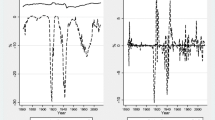Abstract
The aim of this paper is to provide a comprehensive study of public debt, emphasizing the existing distinctions between the emerging and advanced economies across the European Union. Using annual data ranging from 1995 to 2013, we conducted a manifold investigation. Firstly, we studied the descriptive statistics of key variables affecting public debt dynamics. We found that the ex-communist countries recorded lower public debt ratios, negative flow costs and primary deficits. By comparison, the advanced economies achieved primary surpluses in order to balance larger public debt-to-GDP ratios and positive flow costs. Secondly, using the accounting approach we analyzed the dynamics of public debt. The results indicated unstable patterns for the Czech Republic, Latvia, Lithuania, Poland, Slovakia, Slovenia, Cyprus, France, Germany, Greece, Ireland, Italy, Malta, Portugal, Spain and the United Kingdom. Employing a logit model with fixed effects, we also showed that running primary deficits is more likely to increase the probability of having unstable dynamics of public debt. Thirdly, we examined the distribution of the flow cost which revealed the existence of fat tails, suggesting an increased likelihood of large debt burdens. We also found that the uncertainty of the future debt burden is mainly driven by the variability of the real GDP growth rate.



Similar content being viewed by others
Notes
Croatia is not included in our analysis due to lack of sufficient data.
Following Aizenman and Pasricha (2010), we refer to the differential between the real interest rate on public debt and the real GDP growth rate as the flow cost and to the product between the flow cost and the public debt-to-GDP ratio as the debt burden.
References
Adema W, Fron P, Ladaique M (2011) Is the European Welfare State Really More Expensive?: indicators on social spending, 1980–2012, and a Manual to the OECD Social Expenditure Database (SOCX). OECD Social, Employment and Migration Working Papers 124
Aizenman J, Pasricha GK (2010) Fiscal fragility: what the past may say about the future. NBER working paper 16478
Bartolini L, Cottarelli C (1994) Government Ponzi games and the sustainability of public deficits under uncertainty. Ric Econ 48:1–22
Blanchard O, Chouraqui JC, Hagemann PR, Sartor N (1990) The sustainability of fiscal policy: new answers to old questions. OECD Economic Studies 15
Buiter WH (2004 revised) Fiscal sustainability. Paper presented at The Egyptian Center for Economic Studies, October 2003
Buiter W, Lago R (2001) Debt in transition economies: Where it is heading, What can be done about it? Revue d’économiefinanciére 6:191–213
Chalk N, Hemming R (2000) Assessing fiscal sustainability in theory and practice. IMF Working Paper WP/00/81
Cuddington JT (1997) Analyzing the sustainability of fiscal deficits in developing countries. Policy Research Working Paper Series 1784, The World Bank
Dabrowski M (1995) Western Aid conditionality and the post-communist transition. CASE Network Studies and Analysis No. 37
De Grauwe P, Ji Y (2012) Mispricing of sovereign risk and macroeconomic stability in the Eurozone. J Common Market Stud 50:866–880
Domar ED (1944) The burden of the debt and the national income. Am Econ Rev 34(4):798–827
Égert B (2015) Public debt, economic growth and nonlinear effects: myth or reality? J Macroecon 43:226–238
Escolano J (2010) A practical guide to public debt dynamics, fiscal sustainability, and cyclical adjustments of budgetary aggregates. Technical Notes and Manuals, International Monetary Fund
European Commission (2006) The long term sustainability of public finances in the European Union. European Economy 4
Ghosh A, Kim J, Mendoza E, Ostry J (2013) Fiscal fatigue, fiscal space and debt sustainability in advanced economies. Econ J 566:F4–F30
Hurlin C, Popescu A, Turcu C (2013) Sovereign Debt and systemic ris. Paper presented at INFER International Workshop ‚From Economic Crisis Towards Economic Growth: Fiscal and Monetary Policy Instruments’, September 26–27, 2013, Bucharest
International Monetary Fund (2013) World Economic Outlook Database
National Bank of Romania (1998) Annual Report
O’Connell SA, Zeldes SP (1988) Rational ponzi games. Int Econ Rev 29:431–450
Reinhart C, Rogoff K (2011) A decade of debt. Peterson Institute for International Economics, Washington, DC
Reinhart C, Reinhart V, Rogoff K (2012) Public debt overhangs: advanced-economy episodes since 1800. J Econ Perspect 26(3):69–86
Schoder C (2014) The fundamentals of sovereign debt sustainability: evidence for 15 OECD countries. Empirica 41:247–271
Scott A (2010) Government debt after the crisis. Politics, economics and global governance: The European Dimensions Policy Paper 7
Turner D, Spinelli F (2011) Explaining the interest-rate-growth flow cost underlying government debt dynamics. OECD economics department working papers 919
Zaidi A, Rejniak M (2010) Fiscal policy and sustainability in view of crisis and population ageing in Central and Eastern European countries. Policy Brief, European Centre
Acknowledgments
We express our gratitude for useful comments and suggestions to Elias Soukiazs (University of Coimbra), Dimitros Paparas (Harper Adams University), Enrico Marelli (University of Brescia) and to the participants at the 16th INFER Annual Conference (Pescara, Italy). This paper was co-financed from the European Social Fund, through the Sectorial Operational Programme Human Resources Development 2007–2013, project number POSDRU/159/1.5/S/138907 “Excellence in scientific interdisciplinary research, doctoral and postdoctoral, in the economic, social and medical fields -EXCELIS”, coordinator: The Bucharest University of Economic Studies.
Conflict of interest
The authors declare that they have no conflict of interest.
Author information
Authors and Affiliations
Corresponding author
Rights and permissions
About this article
Cite this article
Stoian, A., Iorgulescu, F. The study of public debt: which are the distinctions between the emerging and advanced economies in the European Union?. Empirica 43, 167–196 (2016). https://doi.org/10.1007/s10663-015-9299-x
Published:
Issue Date:
DOI: https://doi.org/10.1007/s10663-015-9299-x




